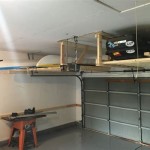How to Concrete a Garage Floor
A concrete garage floor offers durability, ease of cleaning, and aesthetic appeal. While the process may seem daunting, concrete is a forgiving material that allows for room for error. This article will guide you through the steps of creating a new concrete garage floor, ensuring a smooth and successful outcome.
1. Preparation: The Foundation for a Strong Floor
Preparation is crucial for a lasting concrete floor. It begins with removing the existing floor, if applicable. This involves removing any debris, old concrete, or loose gravel. The next step is to excavate the area, ensuring enough space for the concrete slab and a layer of compacted gravel. The depth of excavation will depend on the desired thickness of the concrete slab, usually between 4 and 6 inches.
After excavation, carefully compact the soil with a plate compactor or a hand tamper. This prevents settling and ensures a stable base for the concrete. Following compaction, lay down a layer of gravel, typically 4 inches deep. This layer acts as drainage and further reinforces the foundation. Compact the gravel thoroughly to create a solid bed for the concrete.
Before pouring the concrete, install any necessary plumbing or electrical lines. This includes running water lines for a sink or drainage lines for a sump pump. Ensure all lines are properly secured and insulated to prevent damage during the concrete pour.
2. Formwork: Defining the Shape and Structure
Formwork provides the shape and boundaries for your concrete floor. It is typically constructed using plywood sheets or concrete forms. Ensure the formwork is level and plumb, as any irregularities will be reflected in the final concrete surface. Securely support the formwork with stakes or braces to prevent movement during the concrete pour.
Utilize a level to ensure the formwork is at the desired height. Remember to account for the thickness of the concrete slab when determining the height of the formwork. Also, consider any desired slopes for drainage. A slight slope towards a drain or towards the garage door is recommended to facilitate water runoff.
For a smoother finish, consider using a vapor barrier before pouring the concrete. This barrier prevents moisture from the ground from migrating into the concrete, reducing the risk of cracking and moisture-related issues. Secure the vapor barrier to the formwork using staples or tape.
3. Concrete Pouring: A Precise and Steady Process
The concrete pouring process requires precision and steady timing. Before pouring, ensure the area is clear of any debris or obstacles. Pour the concrete in a controlled manner, allowing it to flow evenly into the formwork. Use a shovel or a concrete trowel to spread the concrete evenly and eliminate any air pockets.
For large areas, consider using a concrete pump to deliver the concrete efficiently. Ensure the concrete is properly consolidated, removing any air bubbles that may lead to weak spots in the concrete. Vibration tools are essential for compacting the concrete, ensuring a dense and durable surface.
A finishing trowel is used to smooth the surface of the concrete after it has partially hardened. This process requires patience and a steady hand to achieve a smooth, even finish. Avoid overworking the concrete as it can lead to cracking or surface imperfections.
4. Curing: Strengthening the Concrete
Curing refers to the process of allowing the concrete to harden and gain strength. This is a crucial step that determines the final quality and durability of the concrete floor. After pouring, cover the concrete with plastic sheeting or a curing compound. This helps retain moisture and prevents the concrete from drying out too quickly.
Regularly mist the concrete with water to maintain moisture levels. Avoid letting the concrete dry out completely, as it can impact its strength and durability. The curing process typically takes 28 days, allowing the concrete to reach its full strength.
While waiting for the concrete to cure, consider incorporating a sealant or a protective coating. A sealant helps prevent staining and wear and tear, while a coating enhances the overall appearance of the floor. Choose a sealant or coating suitable for garage environments, ensuring it provides adequate protection against moisture and chemicals.
By following these steps and paying close attention to detail, you can successfully concrete your garage floor, creating a durable, functional, and aesthetically pleasing space.

4 Simple Steps To Reviving Your Concrete Garage Floor Coatings

How To Remove Flooring From Concrete Decorative

How To Compete With And Win Against Diy Garage Floor Kits Concrete Decor

5 Signs It S Time To Replace Your Garage Floor Johnson Concrete

Polished Concrete Garage Floor Stands The Test Of Time

Why Concrete Staining Is Perfect For Your Garage Trico Painting

Concrete Garage Floor Repair And Leveling Services

How To Paint A Garage Floor Clean And Scentsible

Concrete Garage Floor Demolition Setup And Pour

Garage Concrete Floor Slab Construction Thickness And Cost The Constructor
Related Posts








